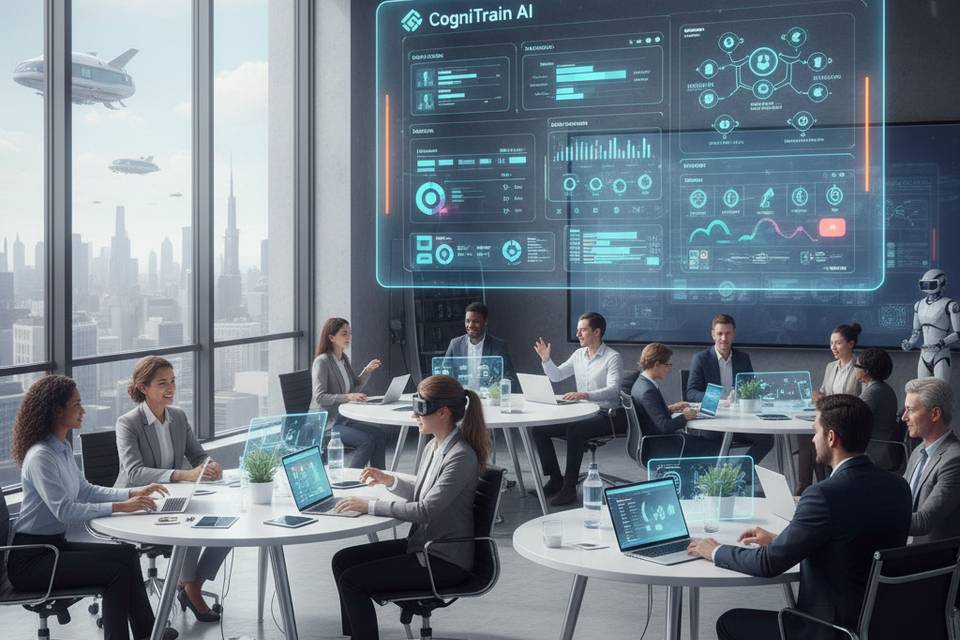How AI Is Transforming Employee Training in 2025 (and What L&D Teams Can Do Now)
Mario Cabral
Sep 29, 2025 • 9 min read
See how AI is transforming employee training in 2025. Learn how to use personalized learning, AI-powered authoring, SCORM/LMS integration, and data-driven analytics to modernize your L&D program.

The pressure on training teams has never been higher. New tools launch weekly, roles evolve faster than ever, and hybrid work makes consistency a challenge. In 2025, forward-looking L&D leaders are meeting this moment by rethinking how learning is created, delivered, and measured—with results that tie directly to business outcomes.
Why 2025 Marks a Turning Point for AI in Employee Training
Employee training is moving beyond one-size-fits-all courses toward dynamic, personalized learning experiences that evolve with your workforce. Three forces are driving this change:
AI-enabled authoring and delivery address all three—accelerating content creation, adapting learning paths in real time, and simplifying distribution across your LMS, website, or intranet while capturing analytics you can act on.
How AI Changes the Employee Training Workflow
AI now supports the full lifecycle of learning—from course design to delivery and analysis.
Modern AI-first platforms like LearningStudioAI bring all these capabilities together, allowing trainers to design complete, interactive learning experiences—not just generate text.
Top 2025 AI Trends Reshaping Corporate Learning
From Onboarding to Upskilling: High-Impact Use Cases

Traditional vs. AI-Augmented Employee Training
| Dimension | Traditional Approach | AI-Augmented Approach | | --- | --- | --- | | Creation speed | Weeks–months of manual drafting and formatting | Draft outlines and lessons in minutes, then refine | | Personalization | Mostly generic content | Role-, level-, and region-specific variants at scale | | Interactivity | Limited quizzes and static slides | Scenario prompts, randomized quizzes, multimedia | | Distribution | Single format; manual LMS upload | SCORM export, PDF, embeds, or hosted in one workflow | | Iteration | Infrequent updates | Continuous improvement based on analytics | | Accessibility | Manual captions and alt text | Built-in narration, captions, and alt-text assistance |
Step-by-Step Blueprint to Modernize Employee Training with AI
1. Pick a visible pilot project Choose a program where improvement is measurable—onboarding ramp time, safety compliance, or product enablement.
2. Gather materials and define outcomes Collect SOPs, playbooks, and SME notes. Clarify which behaviors and metrics you aim to improve.
3. Select an end-to-end platform Look for AI-assisted authoring, multimedia support, interactive assessments, and seamless publishing to LMS and web.
4. Build the course experience Start from an outline, generate draft lessons, and enrich with video, audio, and quizzes. Include scenario-based and microlearning segments.
5. Publish where learners already are Export as SCORM for your LMS, provide quick-guide PDFs, and embed modules in internal sites or wikis.
6. Launch, gather feedback, iterate Monitor analytics, survey learners and managers, and refine weekly instead of quarterly.
Platforms such as LearningStudioAI make this process simple—create courses, add multimedia and interactivity, customize design, and publish as SCORM, PDFs, embeds, or hosted modules without switching tools.
Checklist for Choosing an AI-Powered Training Platform
Best Practices to Maximize Learning Impact
The Metrics That Matter Most in 2025
> ROI example: Cutting course build time by 60% and onboarding by two weeks typically offsets software costs many times over through reclaimed productivity.
Common Pitfalls (and How to Avoid Them)
The Near Future of Workplace Learning
Bringing It All Together
AI is transforming employee training by compressing production cycles, personalizing learning at scale, and giving L&D teams the tools to prove business impact. The most successful organizations in 2025 aren’t just adopting new tech—they’re redesigning how learning works from end to end.
If you want to streamline how your team builds, personalizes, and delivers training, consider an AI-first platform that unifies authoring, multimedia, interactivity, and publishing. LearningStudioAI, for example, lets you create complete learning experiences—then export as SCORM, PDF, embeds, or hosted courses so training meets learners where they are and your LMS captures the results.
By focusing on measurable outcomes, iterative improvement, and scalable design, your organization can turn learning into a lasting competitive advantage in 2025 and beyond.
Share this article:
Keep reading

From Lesson Plan to Online Course: How AI Is Empowering University Educators
Discover how AI helps university educators turn lesson plans into interactive online courses. Includes step-by-step guidance, assessment ideas, multimedia integration, and SCORM/LMS publishing strategies.
Sep 22, 2025

10 Common Mistakes in Online Course Design and How University Educators Can Avoid Them
Explore 10 common online course design mistakes and how university instructors and instructional designers can avoid them. Includes guidance on objectives, engagement, assessments, accessibility, and LMS/SCORM integration.
Sep 15, 2025